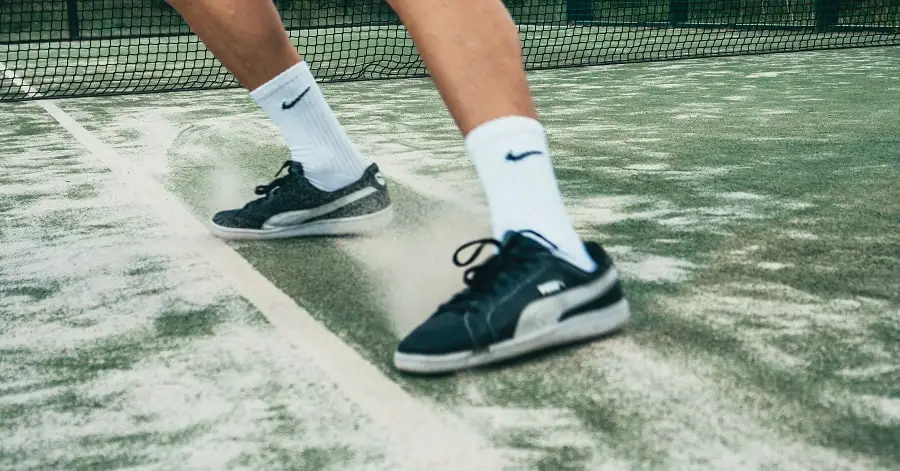I am a tennis player, so I have to wear special non-marking shoes for the courts. I find myself wearing my tennis shoes outside often, and I began to wonder if it was okay for me to do so. After all, non-marking shoes for specific sports can be very expensive, and I wouldn’t want to speed up the damaging process!
So can non-marking shoes be worn outside? The answer is yes, they can be worn outside, but doing so can cause damage to the shoe if the wearer is not careful. Non-marking soled shoes are made for specific indoor sports, so they are not designed to withstand outdoor elements.
It is important to know which shoes are appropriate for which environments, so you can protect the safety of your feet while also saving money by getting the most wear out of your shoes.
What Are Non-Marking Shoes Used For?
Non-marking soled shoes are made for specific indoor sports and their respective courts/fields. The reason they are called non-marking is that they do not leave marks or footprints from the soles of their shoes the way hard soles do. They also have a different type of support or comfort depending on the needs of the athlete playing the sport.
For example, tennis players need shoes sturdy enough to provide them with ankle and heel support, but that also is lightweight enough to allow them to quickly propel laterally, rather than some shoes which are built for more vertical movement.
Non-marking shoes are built much differently than hiking shoes with a rough, textured sole. If you were to hike outside with non-marking shoes, they would get damaged much faster than a shoe built for that specific environment.
The sole of a non-marking shoe is made from rubber or a material similar to rubber that offers maximum levels of friction that leave no trace behind them.

When Should You Wear Non-Marking Shoes?
There are several sports that require special types of non-marking shoes to keep the courts/fields clean and to keep the players safe. If you are trying any of these sports, you might want to consider investing in a pair. Some of these sports include:
- Tennis
- Badminton
- Squash
- Basketball
- Indoor/turf soccer
- Futsal
- Handball
- Volleyball
It’s also helpful to note that non-marking shoes can be worn in non-damaging, non-sports-related outdoor environments. For example, many people wear non-marking soled shoes to wear on boats so that they do not leave visible footprints that require a lot of clean-up.
As long as you use discretion, you can wear “indoor shoes” outdoors, but just be aware of the potential damage.

How Do I Tell If Shoes Are Non-Marking?
It’s easy to tell if shoes are non-marking. All you need to do are a few little tests that require your finger and an easy household object. The first test requires your finger.
Simply press your thumb or a fingernail into the sole of your shoe. If the sole stays dented for a while, you are dealing with a marking sole, but if your sole bounces back quickly, then it is a non-marking sole.
The other test requires a piece of paper:
- Simply place a clean piece of paper on the ground.
- Step on it with the shoe and rub hard enough to make a print, but do not rip the paper.
- Once you remove your shoe, check to see if there is a mark.
- You can also do this by just holding the shoe and pressing it into the paper.
- If there is a mark, you’re dealing with a marking sole and if it there isn’t, it is a non-marking sole. Pretty easy!
Can Non-Marking Shoes Be Used for Running?
Non-marking shoes can be used for running, but it is not recommended. Just like there is nothing necessarily wrong with wearing indoor shoes outside, there is nothing wrong with wearing non-marking shoes for running. However, it might not be the safest option, especially if you are just beginning to run.
Additionally, your non-marking shoes will not last as long as they could or should last, so you will be losing money in the long run by replacing your shoes more often than you would typically have to when used properly.
Like any other sport, you should invest in the right equipment to protect your body. Running shoes are made specifically to provide durability for long distances. They often provide arch support and heel cushioning which can also protect from issues such as plantar fasciitis.
Over time, if you run in the wrong shoes, you could also develop shin splints. With that being said, it is important to stick to reliable running shoe brands to best enhance your practice, just like you should stick to other reliable non-marking brands for sports specific activity.
How to Choose Which Shoe is Best For You
The type of shoe you purchase should be based on a specific activity. Although it might be an expensive habit, it is best to invest in different shoes for different activities. In the long-term, it can save you from injury and potential costs of rehab or physical therapy that the wrong shoe might have caused you.
Moreover, you are more likely to run through shoes much faster if you use one pair for every different type of activity, so the cost of investing in more expensive, specific shoes will likely end up evening themselves out.
With that being said, stick to non-marking, indoor shoes if you are looking to play any of the aforementioned sports such as tennis, badminton, squash, volleyball, indoor soccer, etc. If you are into outdoor activities such as hiking and running, make sure you have a specific pair of shoes to cater to those individual needs.
And of course, if you are ever unsure of the use of a shoe or the types of soles they have, it is best to look to the experts!
